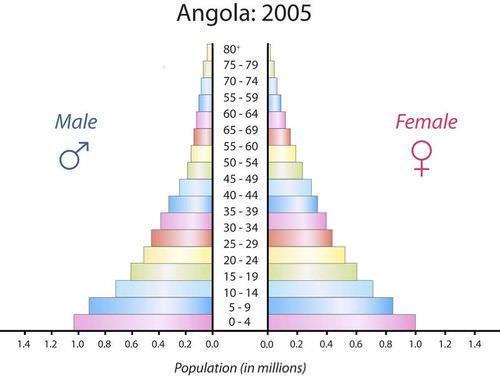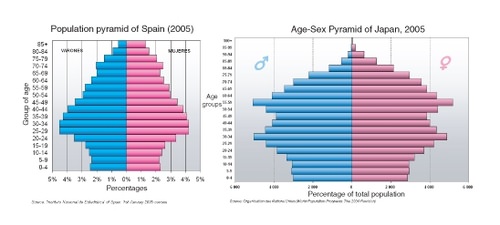18.35 最近人类人口增长 -- -- 先进
Section outline
-
How long does it take to add 1,000,000,000 people?
::增加1000万人需要多长时间?Some may say not long enough. Recent human shows that we are adding a billion people in a little over a decade. Is that too fast?
::有人可能会说时间不够长。最近的人类显示,我们在10年多一点的时间里增加了10亿人。这是否太快了?Recent Population Growth
::最近的人口增长Death rates have fallen throughout the world, so that no country today is considered to remain in Stage 1 of the . Countries appear to vary with respect to the timing of Stages 2 and 3. Many less developed countries remain in Stage 2, including Yemen, Afghanistan, Bhutan, Laos, and part of Sub-Saharan Africa.
::全世界死亡率已经下降,因此,今天没有一个国家被认为仍然处于第一阶段,第2阶段和第3阶段的时间安排似乎有所不同,许多欠发达国家仍然处于第二阶段,包括也门、阿富汗、不丹、老挝和撒哈拉以南非洲部分地区。Angola’s age structure ( Figure ) reveals accelerating Stage 2 growth. Widest at its base, the structure indicates many youths who will survive to reproduce at their parents’ high fertility rates because death rates are declining. Some countries, particularly those in regions of Africa which have been devastated by AIDS, appear stalled in Stage 2 due to disease and stagnant . The demographic transition model may not prove to fit population growth in developing countries. Poor, low-income people in undeveloped countries have the highest birth rates. If demographic transition requires wealth and education, the world’s unequal distribution of development and resources may mean that these high birth rates will merely maintain exponential growth , rather than precipitate the social change associated with industrialization.
::安哥拉的年龄结构(图 ) 揭示了加速的第二阶段增长。 基点最宽的这一结构表明许多年轻人将存活在父母的高生育率下,因为死亡率正在下降。 一些国家,特别是非洲地区被艾滋病摧毁的国家,似乎由于疾病和停滞而停滞在第二阶段。 人口转型模式可能无法适应发展中国家的人口增长。 贫穷、低收入的不发达国家人口出生率最高。 如果人口转型需要财富和教育,那么世界的发展和资源分配不均可能意味着这些高出生率只会维持指数增长,而不是催生与工业化相关的社会变化。Angola’s population pyramid reflects Stage 2 growth: The wide bars at its base show the many youths who will survive to reproduce at their parent’s high fertility rates because death rates (small steps moving up the pyramid) are declining.
::安哥拉人口金字塔反映了第2阶段的增长:其底部的宽条显示许多年轻人将活下来,在父母的高生育率下繁殖,因为死亡率(向金字塔上移动的小步)正在下降。However, many countries appear to have begun the shift to Stage 3. Fertility rates have dropped 40% throughout much of South America, the Middle East, and the Pacific Islands. Countries such as India, Bangladesh, and Zimbabwe have lowered birth rates between 25-40%, and others such as Pakistan, Saudi Arabia, and Haiti have reduced fertility to 10-25% of earlier rates. in most of these countries are beginning to level off, although resistance to change in the social factors which reduce birthrate may delay or prevent this response. Ecologist Garrett Hardin has pointed out that voluntary birth control selects against people who use it; by itself, voluntary control is unlikely to limit population growth.
::然而,许多国家似乎已经开始转向第三阶段。 南美洲、中东和太平洋岛屿的大部分地区,生育率已经下降了40%。 印度、孟加拉国和津巴布韦等国家已经降低了25%-40%的出生率,巴基斯坦、沙特阿拉伯和海地等其他国家已经将生育率降低到早前水平的10%-25%。 在这些国家中,大多数国家已经开始稳定下来,尽管对降低出生率的社会因素变化的抵制可能会推迟或阻止这一反应。 生态学家加雷特·哈丁指出,自愿节育选择了使用这种节育的人,而自愿节育本身不太可能限制人口增长。High levels of industrialization and development have led to replacement (or lower) fertility rates in most of Europe, the United States, Canada, Australia, Brazil, China, and Thailand. China, Brazil, and Thailand passed through demographic transition extremely rapidly due to rapid economic and social changes. Replacement fertility includes 2 children to replace parents and a fraction of a child to make up for early mortality and at-birth sex ratio differences. Because mortality rates vary, replacement fertility rate ranges from 2.5 to 3.3 in poor countries, but averages 2.1 in developed countries. Globally, replacement fertility is 2.33 children per woman. In Stage 3 countries, populations will eventually stabilize if replacement fertility continues. However, many - including the US – continue to grow rapidly due to the “youth bulges” of exponential Stage 2 growth. The age structures of China and the US ( Figure ) show demographic transition, but also youth bulges which will mean continuing growth for some time.
::高水平的工业化和发展水平导致欧洲、美国、加拿大、澳大利亚、巴西、中国和泰国的生育率更替(或更低 ) 。 中国、巴西和泰国由于经济和社会的快速变化,经历了极快的人口转型。 更替生育率包括2个孩子来取代父母,还有一小部分孩子来弥补早期死亡率和出生时性别比的差异。 由于死亡率不同,更替生育率在贫穷国家为2.5到3.3,但在发达国家平均为2.1。 从全球来看,更替生育率是每名妇女2.33个孩子。 在第三阶段国家,如果更替生育率继续下去,人口最终会稳定下来。 但是,许多 — — 包括美国 — — 将继续快速增长,因为第2阶段快速增长的“青年暴增 ” 。 中国和美国(图 ) 的年龄结构显示了人口转型,但年轻人的更替率也显示出一定时期的持续增长。Population pyramids for China (above) and the U.S. (below) show decreased birth rates which suggest they have reached Stage 3 of the demographic transition model. Both countries show a population bulge remaining from Stage 2 exponential growth, so populations will continue to grow for a number of years. Eventually, if birth rates remain at replacement levels, populations will stabilize in Stage 4.
::中国的人口金字塔(以上)和美国(下文)的人口金字塔(下文)显示出生率的下降表明它们已经达到了人口转型模式的第三阶段。 两国都显示人口在第二阶段指数性增长之后还有人口暴增,因此人口将继续增长数年。 最后,如果出生率保持更替水平,人口将在第四阶段稳定下来。Some countries have lowered birthrates below death rates so that r is actually negative. Japan, Germany, Italy, Spain, Portugal, and Greece are not producing enough children to replace their parents; populations in some of the southern European countries have already begun to decline. Top-heavy age structures for Spain and Japan are shown in Figure . In countries such as Russia, negative growth emerged suddenly from economic and political crises which caused emigration , declining fertility, and increased male mortality, rather than from development and wealth as the transition model predicts. Negative growth rates pose economic threats: growth-dependent industries decline, and the burden of a large aging, economically dependent population falls on a smaller group of young workers. These shrinking population conditions are sometimes referred to as "Stage 5" of the demographic transition.
::有些国家将出生率降低到死亡率以下,以致死亡率实际上为负数。 日本、德国、意大利、西班牙、葡萄牙和希腊没有生产足够的儿童来替代父母;一些南欧国家的人口已经开始下降。 图中显示了西班牙和日本的超重年龄结构。在俄罗斯等国家,经济政治危机突然出现负增长,导致人口向外移民、生育率下降和男性死亡率上升,而不是转型模式预测的发展和财富。 负增长率构成了经济威胁:依赖增长的产业衰退,以及大量老龄化、经济依赖人口的重担落在较小的年轻工人身上。 这些人口条件的萎缩有时被称为人口转型的“第五阶段 ” 。The top-heavy age structures for Spain and Japan show declining populations due to birth rates which have fallen below already-low death rates. Unless significant immigration occurs, these countries may suffer negative economic effects, such as decline in growth-dependent industries. The burden of a large aging, economically dependent population may fall on a smaller group of young workers.
::西班牙和日本头重脚轻的年龄结构表明,由于出生率已经低于已经很低的死亡率,人口正在下降。 除非出现大量移民,否则这些国家可能会受到负面的经济影响,如依赖增长的行业的衰退。 大量老龄化、经济上依赖经济的人口可能落在人数较少的年轻工人身上。Summary
::摘要-
No country remains in Stage 1.
::没有一个国家处于第一阶段。 -
A number of poor, undeveloped countries remain in stage 2; age pyramids show large youth populations.
::一些贫穷、欠发达国家仍处于第二阶段;年龄金字塔显示青年人口众多。 -
Many countries have entered Stage 3, with some lowering fertility rates by as much as 40%, but pyramid “youth bulges” mean they continue to grow.
::许多国家已进入第三阶段,有些国家的生育率下降高达40%,但金字塔“青年膨胀”意味着生育率继续增长。 -
Replacement fertility varies from country to country because death rates vary.
::更替生育率因国而异,因为死亡率不同。 -
A few countries have reduced fertility rates below replacement and are shrinking in population.
::一些国家将生育率降低到更替水平以下,人口正在减少。 -
Shrinking countries may for a time experience economic difficulties related to an aging population.
::不断缩小的国家在一段时间内可能遇到与人口老龄化有关的经济困难。
Review
::回顾-
Why is no country in Stage 1?
::为什么没有一个国家处于第一阶段? -
Explain why replacement fertility must exceed 2 children per female.
::解释为什么更替生育率必须超过每名女性2个子女。 -
What is Stage 5? What causes this stage?
::第五阶段是什么?
Explore More
::探索更多 -
No country remains in Stage 1.



